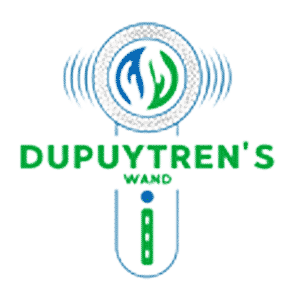
What Is the Newest Treatment for Dupuytren’s Contracture?
Share
Dupuytren’s contracture — sometimes called Dupuytren’s disease, or in lay terms referred to as Viking disease or Viking syndrome hand — is a condition in which fibrous tissue in the palm thickens and forms cords that pull one or more fingers toward the palm. Over time, the finger(s) can no longer fully straighten, which can significantly impair daily tasks like typing, gripping, or even putting your hand flat on a table.
While there is currently no definitive cure, the field is evolving rapidly. In recent years, researchers and clinicians have developed new therapeutic approaches — both surgical and non-surgical — with the aim of reducing risk, discomfort, recurrence, and improving outcomes. Below, we explore the latest developments (as of 2025), and then I will share how the Dupuytren’s Wand offers a natural, painless, non-surgical alternative.
Traditional & Established Treatments — A Quick Primer
Before diving into the “newest,” it helps to understand what’s already in use:
- Surgery (fasciectomy / dermofasciectomy): The traditional approach is to surgically remove the diseased fascia or skin. It can be effective, but it comes with the risk of complications (nerve injury, wound healing issues) and recurrence over time.
- Needle aponeurotomy (percutaneous needle release): A minimally invasive technique where a needle is used to puncture and “break” the cord, under local anesthesia. It has the advantage of being performed in-office without major incisions. However, recurrence rates are relatively high.
- Collagenase enzyme injection (e.g. XIAFLEX / collagenase clostridium histolyticum): This is one of the more modern non-surgical options. The enzyme breaks down collagen in the cord, weakening it. A clinician then stretches the finger to rupture the cord. It is FDA-approved in certain settings.
- Radiation therapy (low dose, non-cancerous applications): In certain early-stage cases, low-dose radiotherapy is being explored as a way to slow or halt disease progression.
- Drug therapies under investigation: Researchers are studying anti-fibrotic agents, immunomodulators, and molecular inhibitors targeting underlying cellular pathways (for example, anti-TNF therapy).
What’s NEW (2024–2025) in Dupuytren’s Treatment?
Thanks to ongoing research, a few cutting-edge and emerging options are gaining attention.
1. Adjuvant Radiation Therapy to Reduce Recurrence
A recent clinical trial (the DEPART trial) has tested radiation therapy used after standard treatments (like surgery or needling) to reduce recurrence. Their early findings suggest that adjuvant radiation is safe, with minimal adverse effects, and may help “lock in” the benefits of other interventions.
This is exciting because one of the biggest challenges in Dupuytren’s care is recurrence. Even after surgery or injections, many patients experience a return of contractures over 5–10 years. The idea is that radiation might prevent the fibroblasts from re-activating.
2. Drug / Molecular Therapies — Targeting the Disease, Not Just the Symptoms
Perhaps one of the most promising advances is the push toward disease-modifying therapies — medical treatments that act on the root biological processes, not just cutting or dissolving cords.
- VEN-201 by Ventoux Biosciences is one such investigational therapy under development. It's described as an immuno-fibrotic modulator designed to shift immune and fibrotic signaling to reduce or prevent progression of Dupuytren’s disease.
- Anti-TNF injections (e.g. adalimumab): In a clinical trial conducted by the University of Oxford, injecting adalimumab (an anti-TNF biologic) into Dupuytren’s nodules was shown to reduce nodule hardness and size in early-stage disease. The results were promising in terms of safety.
- Collagenase nanocapsules: A more technical, experimental approach involves encapsulating collagenase in nanoparticle delivery systems, allowing controlled release over several days, potentially improving efficacy and reducing side effects.
These therapies are not yet standard of care; many are in preclinical or early clinical stages. But they herald a shift from “cut or break the cord” toward “modulate or reverse the disease.”
3. Better Evidence Comparing Modalities
The 2024 study published in NEJM comparing collagenase injection versus limited surgery provided more robust comparative data, helping physicians choose between modalities based on outcomes rather than tradition.
As more large trials come online, we’ll see refined protocols, patient stratification (who benefits most from which method), and combinations (e.g. inject + adjunct therapy + radiation) tested.
How the Dupuytren’s Wand Can Help
While medical and surgical treatments for Dupuytren’s contracture continue to advance, many patients prefer a non-invasive, natural, and painless approach. The Dupuytren’s Wand offers an effective way to manage early-stage Dupuytren’s, helping to improve hand mobility without surgery.
This gentle, non-surgical method works by gradually stimulating and supporting the soft tissue and fascia, allowing the hand to maintain flexibility naturally. It can be used at home or under guidance, requires no anesthesia or downtime, and provides a safe alternative for those seeking early intervention or wanting to complement other treatments.
“The Dupuytren’s Wand is a simple, natural, and highly effective option for supporting hand function in Viking syndrome hand, without the risks of surgery.”
Because many advanced therapies are still in development or trials, the Wand presents an accessible, low-risk solution for patients who want to slow progression, maintain hand function, and manage Dupuytren’s contracture effectively.
Read more about Dupuytren’s Contracture Treatment
What Patients Are Searching (and Want to Know)
Understanding user intent helps shape useful blog content. Based on recent trends, people are Googling:
- “non surgical treatment for Dupuytren’s contracture”
- “Dupuytren’s disease cure 2025”
- “Dupuytren’s contracture pain free therapy”
- “Viking hand disease treatment naturally”
- “Dupuytren’s recurrence prevention”
Therefore it’s important to address:
- What options exist without surgery
- What is new or in development (to signal progress)
- Safety, pain, downtime, and recurrence
- Practical advice (when to consult a specialist, how to monitor)
- Testimonials or success stories, where possible
Things to Keep in Mind & Caveats
- Many of the “newest” therapies are still under investigation; they are not yet widely available or approved in all jurisdictions.
- Even with enzyme injections or minimally invasive techniques, recurrence remains a major issue in Dupuytren’s care.
- Patient selection matters: a therapy that works well for early-stage nodules might not do as well in late-stage contracture.
- Safety and side effects must always be weighed. For example, collagenase injections can, in rare cases, cause tendon rupture or skin tears.
Conclusion & Call to Action
In summary:
- The newest frontiers in Dupuytren’s treatment focus on adjuvant radiotherapy to prevent recurrence, and disease-modifying molecular therapies (like anti-TNF injections and novel immuno-fibrotic compounds).
- Established non-surgical options (collagenase injections, needling) are improving in evidence and technique.
- Meanwhile, your Dupuytren’s Wand offers a natural, painless, non-surgical option — suitable especially for early-stage disease, maintenance, or for those who prefer to avoid invasive methods.
If you or someone you know is struggling with dupuytren's viking disease / Viking syndrome hand (Dupuytren’s) and searching for a less invasive solution, consider exploring the Dupuytren’s Wand. I invite you to reach out for a free assessment or demo, and to learn how the Wand method might fit into your treatment journey — either as a standalone approach or complement to emerging medical options.
